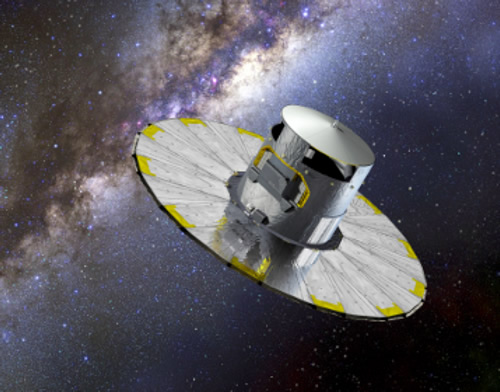
With the largest camera ever to be sent into space, Mission Gaia will image one billion stars, revealing valuable information about the structure and evolution of our home galaxy, as well as discover supernovas, previously unseen asteroids and planets around nearby stars. On November 20, 2013 at Europe's spaceport in Kourou, French Guiana, the ESA will launch its surveyor, Gaia, to engage in a five year mission to map a billion stars with unprecedented precision.
Once in space, Gaia will head towards Lagrange Point, or L2, some 1.5 million km beyond Earth's orbit. Once there, the surveyor will take up its stable position in orbit around the Sun and begin imaging. It will observe an estimated billion stars, repeatedly.
Each observation will reveal information about individual star position and movement. However, that's not all: Gaia will also take measurements of each star's "vital signs," such as stellar temperature, luminosity and chemical composition. These observations will hugely assist astronomers in refining our understanding of our own galaxy, including its origins and evolution.

Artist's Impression of Gaia - ESA
Gaia isn't a lightweight. It consists of two telescopes which rotate slowly, sweeping the expanse of the entire sky and focusing the light of both telescopes simultaneously onto the CCD array of a single digital camera. The camera itself is the largest ever flown into space and has the capacity of nearly a billion pixels! At the Kourou launch area, the last two months have been flurry of tests for the Gaia mission and preparing for launch.
"Getting ready for launch is an extremely busy phase for the mission teams, but it's also extremely exciting and rewarding to see our mission so close to launch," says Giuseppe Sarri, ESA's Gaia project manager.
One of the most fascinating components of the Gaia craft is its sunshield. At the beginning of October, it passed its final deployment test and has now been tucked away in its final configuration, ready for launch. Once the spacecraft reaches its goal, the sunshield will deploy and create a 10.5 meter wide umbrella around the base of the surveyor. This will become a dual-purpose venture: the sunshield will protect the spacecraft's sensitive telescopes and cameras from solar damage - keeping them at a safe operating temperature of -110°C - while the solar panels on the other side will help generate electricity to power the systems.
"With this important milestone -- and others -- now completed, we are working through an intensive checklist of final activities that will culminate in the much-awaited launch of our 'discovery machine'," adds Giuseppe.
By now, at ESA's European Spacecraft Operations Center in Darmstadt, Germany, the Gaia Mission Control Team will have completed a full simulation for crucial launch functions and the beginning phases of the mission's orbit. The Gaia craft itself will have received its fuel supply at Kourou; its tanks topped off and ready to carry out the propulsion system's commands when it makes it into space.
At the beginning of November, Gaia will then be transferred to the Soyuz launch adapter where it will receive its upper stage that will help boost the space traveler along on its journey to L2. During the initial four minutes of launch, Gaia will be outfitted with a Soyuz fairing, a protective nose cone that will shield it against damage.
Then, on November 15, 2013, Gaia will be transferred to the launch pad where it will be mated with the Soyuz launcher and fueled for the ride. Five days later, on November 20, 2013, at 08:57:30 GMT, the spacecraft will take off! If you're interested in watching this historic event, it will be streamed live on the ESA Portal at http://www.esa.int
"We are excited to see the launch less than one month away, but there are still a lot of final preparations to complete," says Timo Prusti, ESA's Gaia project scientist. "Our quest to create an enormous stellar census to solve questions on the origin, structure and evolutionary history of our home galaxy, and to discover tens of thousands of supernovas, previously unseen asteroids and even planets around nearby stars, is finally about to begin."
Just like updating your GPS system, the Gaia Star Survey will update our astronomical catalogs and much, much more. Even given a billion stars, that's only about 1% of the number of stars astronomers estimate to be within the Milky Way. Ah, well. Move over, Hipparchos, there's a new kid on the block!
Original Story Source: ESA News Release
About Tammy Plotner - Tammy is a professional astronomy author, President Emeritus of Warren Rupp Observatory and retired Astronomical League Executive Secretary. She's received a vast number of astronomy achievement and observing awards, including the Great Lakes Astronomy Achievement Award, RG Wright Service Award and the first woman astronomer to achieve Comet Hunter's Gold Status.















